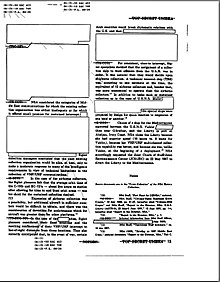Classified information
Classified information is sensitive information to which access is restricted by law or regulation to particular classes of people. A formal security clearance is required to handle classified documents or access classified data. The clearance process requires a satisfactory background investigation. There are usually several levels of sensitivity, with differing clearance requirements. This sort of hierarchical system of sharing information among a group of people is used by most national governments. Deciding the level of sensitivity of data is called data classification.

The purpose of classification is to protect information from being used to damage or cause danger to national security. Classification says what is a "state secret" and deals with different levels of protection based on the damage the information might cause if it reached the wrong hands.
Some non-government organizations and corporations also have their own secret information, normally referred to as trade secrets.
Classification levels change
Although the classification systems vary from country to country, most have levels like the following British definitions (from the highest level to lowest):
- Top Secret (TS)
- The highest level of classification of material on a national level. Such material would cause "exceptionally grave damage" to national security if publicly available.
- Secret
- Such material would cause "serious damage" to national security if publicly available.
- Confidential
- Such material would cause "damage" or be "prejudicial" to national security if publicly available.
- Restricted
- Such material would cause "undesirable effects" if publicly available.
Depending on the level of classification there are different rules controlling the level of clearance needed to view the information, and how it must be stored, transmitted, and destroyed. Access is restricted on a "need to know" basis. Simply possessing a clearance does not automatically authorize the individual to view all material classified at that level or below that level. The individual must have a "need to know" in addition to the proper level of clearance.
Other websites and references change
- US "NISPOM" manual, explaining rules on classified information among other things - full title is "National Industrial Security Program Operating Manual".
- Marking Classified National Security Information ISOO booklet PDF
- Trusted operating systems
- Defense Business Services National Security Vetting (DBS NSV). Carries out national security checks in the UK.
- Los Alamos table of equivalent US and UK classifications Archived 2012-05-10 at the Wayback Machine
- The National Security Archive - a collection of declassified documents acquired through the FOIA
- Lerner, Brenda Wilmoth & K. Lee Lerner, eds. Terrorism : essential primary sources. Thomson Gale, 2006. ISBN 9781414406213 Library of Congress. Jefferson or Adams Bldg General or Area Studies Reading Rms LC Control Number: 2005024002.
- Peter Galison, Removing Knowledge in Critical Inquiry n°31 (Autumn 2004)
- RADNA GRUPA ZA IZRADU ZAKONA O TAJNIM INFORMACIJAMA[permanent dead link], proposition of Serbian non government working group for Classification of secrets law, .DOC Serbian